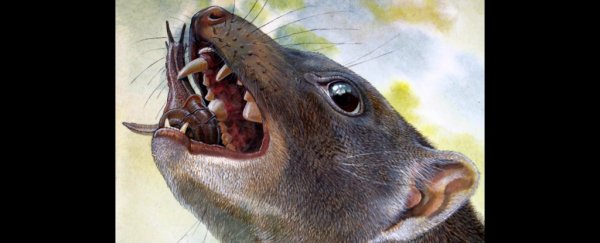If Australia's current treasure trove of weird animals isn't enough for you, just wait till you see the extinct ones. There's the Fangaroo, which was literally a fanged kangaroo, or the Bullockornis planei, which was a 2.5-metre-tall bird scientists nicknamed the Demon Duck of Doom. Not kidding - I couldn't make this stuff up.
And now, researchers have added to the collection a previously unknown marsupial, Malleodectes mirabilis, which enjoyed eating snails, and had one huge tooth that could crush the snail shells into a pulp. Seriously, what the hell, Australia?
"Malleodectes mirabilis was a bizarre mammal, as strange in its own way as a koala or kangaroo," says study leader, Mike Archer, from the University of New South Wales in Sydney. "Uniquely among mammals, it appears to have had an insatiable appetite for escargot - snails in the whole shell. Its most striking feature was a huge, extremely powerful, hammer-like premolar that would have been able to crack and then crush the strongest snail shells in the forest."
The remains of the species were found in a cave at Riversleigh, known as site AL90, which researchers say is a total treasure trove of cool fossils, because animals kept falling in and getting stuck.
"Many other animals that lived in this lush forest met a similar fate with their skeletons accumulating one on top of another for perhaps thousands of years, until the cave became filled with palaeontological treasures," said one of the team, Suzanne Hand.
"Over millions of years the walls and ceiling of the cave were eroded away, leaving only the fossil-rich floor, which was discovered by our Riversleigh Project team members in 1990."
Since 1990, the site has produced thousands of fossils, including a sloth-like marsupial the size of a ram, called the Nimadon.
Back when these types of creatures roamed 15 million years ago, Australia would have been full of dense rainforests, which have mostly been replaced now by open forests and grasslands. Nimadons would have fallen into the cave while moving through the treetops.
The researchers have found other fossils of the snail-loving Malleodectes mirabilis in the past, but it wasn't known exactly what the creature was until a well-preserved portion of the skull was discovered recently. Encased in limestone, the team extracted the skull using a diluted acid bath (which doesn't damage the fossil), revealing that the animal was a juvenile, with its adult teeth about to erupt.
"Details of the canine, premolar and molar teeth of this specimen have enabled its relationships to other Australian marsupials to be determined with reasonable confidence," says Archer. "Although it is very different from the others, it appears to have been related to the dasyures - marsupial carnivores such as Tasmanian devils and the extinct Tasmanian tigers that are unique to Australia and New Guinea."
Here's hoping the team find even more weird and wonderful animals in the cave, and across Australia. We're putting our money on a giant platypus - oh wait, they've already been discovered.
The research has been published in the journal Scientific Reports.
UNSW Science is a sponsor of ScienceAlert. Find out more about their world-leading research.
